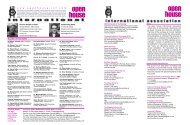Vol :37 Issue No.1 2012 - Open House International
Vol :37 Issue No.1 2012 - Open House International
Vol :37 Issue No.1 2012 - Open House International
Create successful ePaper yourself
Turn your PDF publications into a flip-book with our unique Google optimized e-Paper software.
Figure 5. Although contemporary hanoks in Bukchon maintain the tripartite wall composition described in the design guidel<br />
ine, they are far from the imagined lifestyle of restraint and simplicity. Source: Author.<br />
fortress-like structures with a hint of traditional form<br />
such as tiled roofs. To a certain extent, such unconventional<br />
treatment of façade is due to the cramped<br />
urban condition which does not allow enough<br />
space for a courtyard. Others note that urban<br />
hanoks are fundamentally different from hanoks in<br />
the earlier period since the prototype continues to<br />
adapt to the process of urbanization and industrialization.<br />
While this observation supports a more flexible<br />
interpretation of tradition, it alone cannot<br />
account for the stylistic uniformity in Bukchon.<br />
Notwithstanding the fact Bukchon was a popular<br />
residential district for upper class literati, there was<br />
no strict segregation according to class which<br />
means that diverse house types co-existed. In fact,<br />
even during the Chosun Dynasty, numerous distinct<br />
vernacular dwelling types such as log cabins,<br />
thatched roof houses, and shingle-roofed houses<br />
were common.<br />
L OC AL U RB AN CONDITIONS<br />
Despite relatively slower urban growth of historical<br />
part of Seoul, the area near Bukchon has seen<br />
many commercial developments. For instance, fifteen-story-high<br />
Hyundai Building, constructed in<br />
1986, abuts the edge of Bukchon (Fig. 6). Another<br />
large structure is the Constitutional Court, also constructed<br />
in the 1980s causing demolition of old<br />
hanoks in the area. Establishment of large commercial<br />
and governmental agencies prompted<br />
development of small businesses such as restaurants<br />
and cafes. Recent designation of the area as<br />
a historical cultural district, where reconstruction of<br />
more than four stories is forbidden, has resulted in<br />
a series of legal battles between corporations and<br />
the city government. Spatial experience of the village<br />
is compounded by commercial development<br />
of Insadong, area south to the village famous for<br />
traditional antique shops and art galleries. Spillover<br />
developments from Insadong, another special<br />
cultural district of Seoul, have permeated into the<br />
formerly quiet residential area. Surrounded by sites<br />
of cultural heritage, the village is vulnerable to<br />
speculation and gentrification.<br />
What is noteworthy is that in this process of constructing<br />
upper class dwellings with full amenities,<br />
conflicts between neighbors escalate. Although the<br />
use of tiled roofs and wooden columns seems to<br />
show attempts to blend into the neighborhood, it is<br />
clear that such gesture stops short of tokenism when<br />
massive wall and broadened road disrupt the traditional<br />
relationship between hanok and streets. The<br />
unconventional construction method produced friction<br />
between the existing residents who suffered<br />
from the high level of noise coming from the construction<br />
sites. Others observed the process of gentrification<br />
when previous residents in Samchungdong<br />
part of the village sold their houses to the rich<br />
outsiders after the sharp rise in land price (Lee<br />
2008). In addition, division between NGOs after<br />
the beginning of the regeneration project is pointed<br />
out as contributing to the process of community’s<br />
disintegration (Lee 2006). Ironically, the effort to<br />
revitalize vernacular house form has resulted in perverse<br />
transformation of hanok. At the same time,<br />
the dream of cultivating idyllic communitarian<br />
neighborhood proved premature when construction<br />
of fortress-like hanok contributed to the conflicts<br />
among residents.<br />
4 5<br />
open house international <strong>Vol</strong>.<strong>37</strong> <strong>No.1</strong>, March <strong>2012</strong> Remodelling Of The Vernacular In Bukchon Hanoks Jieheerah Yun





